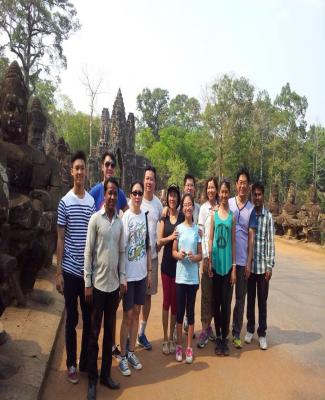

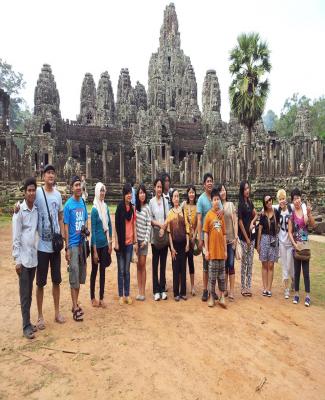
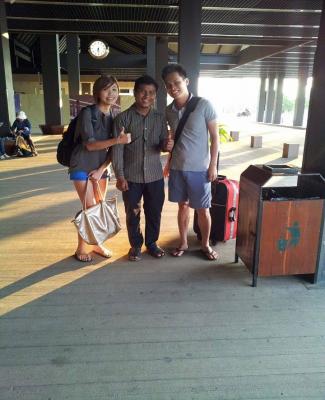
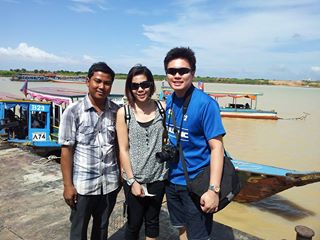
.jpg)
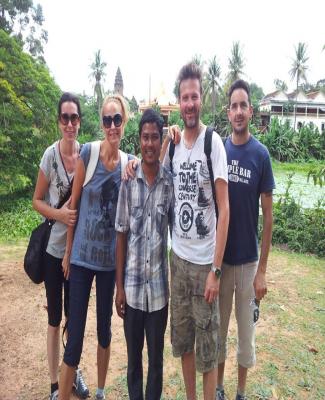
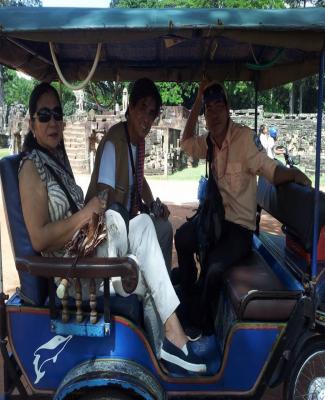
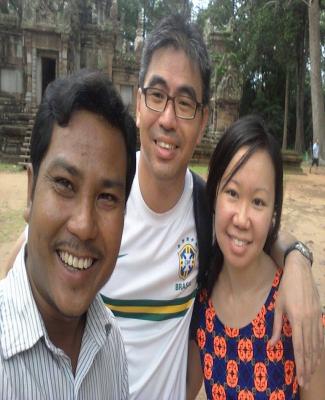

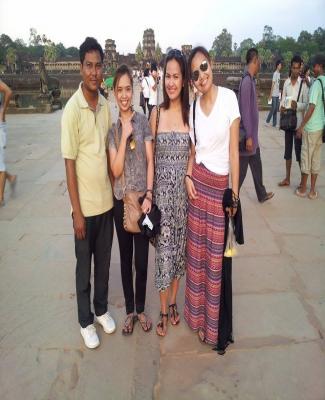
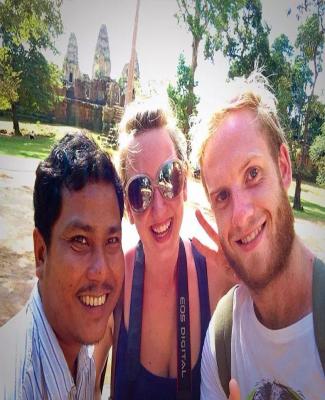
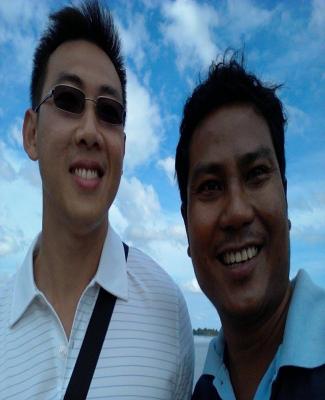
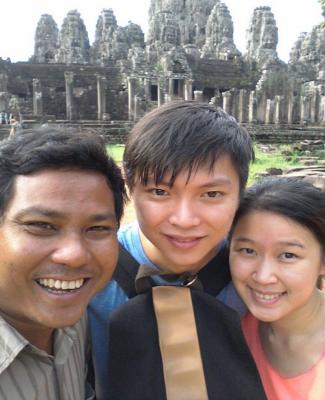
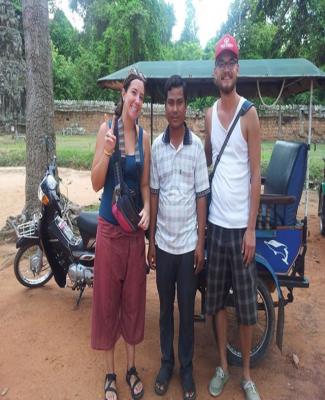

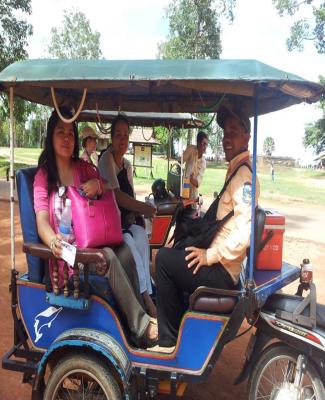
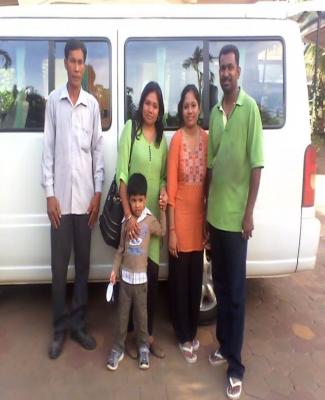
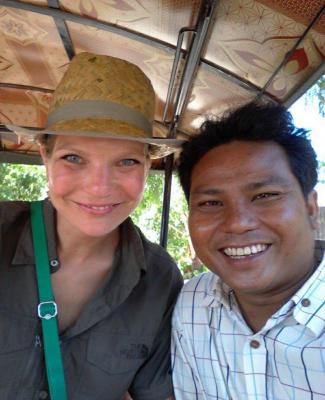
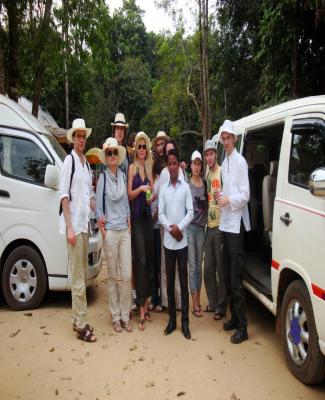
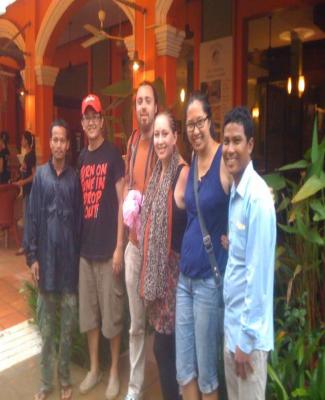

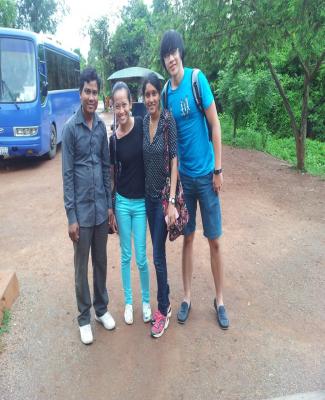
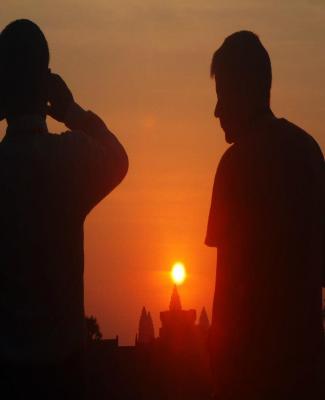
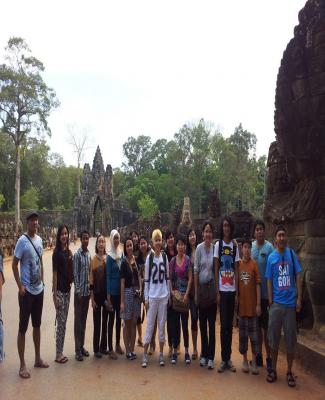
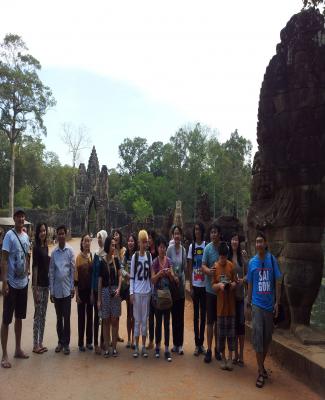
More Temples in Angkor Area
Angkor Small Circuit
Angkor Small Circuit Temples Angkor Wat – Undisputedly the largest religious building in the world, is truly breathtaking. A massive 3 level temple mountain style structure dominated by 5 central towers. Angkor Wat was built in the early 12th century by King Suryavarman II as a temple city. Surrounded by a 200 meter wide moat the site is roughly 2 km across and 2.5 km long with the central building covering about 1 km square. You are free to roam all over the complex however you will have to queue up if you want to see the newly opened sacred central tower. Only 50 people at one time allowed up, waits are generally not too long, and it is worth the short wait.
South Gate Angkor Thom Angkor Thom is another walled and moated temple city. Built by King Jayavarman VII in the early 13th century it covers about 3km square. At the South Gate you will often see a line of elephants that are used to carry people up to the top of the nearby Phnom Bakheng temple which is a popular place to see the sunset or sunrise over Angkor Wat.
Bayon The Bayon is easy to explore and is covered in towers that have a giant face carved on every side. Spend a bit of time with this one, plenty of up and down stairways inside and some beautiful alleyways and colonnades. Look for the Buddha statue with the seven headed Naga. Throughout the site are many carved bas-reliefs depicting everything from battles to scenes of daily life. Preah Ngoc Just past the Bayon you will find a small temple called Preah Ngoc (Preah Ngok). More a chapel than a temple, there is a 5 meter tall statue of a seated Buddha under a small pavilion. While the pavilion is of recent times the Buddha statue comes from the 12-13th century. Local monks can often be seen here conducting services at the site. Baphuon – A few hundred meters north of Preah Ngok you will find the Baphuon. Built by King Udayadityavarman II in the 11th century it is the second oldest building in Angkor Thom. The Baphuon is a large single temple mountain built over 5 levels. Parts of the main structure are undergoing restoration but you can still access the central entrance areas and wander all around the outer walls. There is a 200 meter long elevated causeway leading to the front entrance. Hop down and look at the supporting columns underneath the causeway. This site will be truly magnificent once it is fully restored. Phimeanakas – A few hundred meters further north of Baphuon you will find Phimeanakas, the oldest building in Angkor Thom, built in the 10th century by King Jayavarman V. A temple mountain that looks like a pyramid it is the tallest scalable temple in Angkor Thom.There is a newly constructed set of wooden stairs at the rear that make for an easier climb, though still a bit steep.Legends say that Phimeanakas was topped with a golden tower that housed a Naga serpent which transformed into a beautiful woman every evening. The Angkor Kings had to sleep with this woman every night lest great troubles fall on the kingdom. Sras Srei – Just north of the Phimeanakas is the area where the royal palace once stood. The stone walls that surrounded the palace are still mainly there however the buildings were mainly ornate wood structures they have long decayed.What does remain are 2 bathing pools the largest of which is Sras Srei.This pool is 125 meters long, 45 meters wide, and has terraced steps down all sides. The steps are ornately carved with lots of images of animals and marine life. A lovely shady and cool spot to stop for a rest on a hot day. You may even find some of the local kids having a swim. Terrace of Elephants – Heading back to the main road through Angkor Thom you will find the magnificent Terrace of Elephants.Built in the 12th century by King Jayavarman VII it is 300 meters long and 3 meters high. If you walk along the front you will see all the types of animals caved into the stone face with some lovely carved elephants. The elephants also frame the sides of the staircases. At the northern end of the terrace is another terrace called the Terrace of the Leper King. There are plenty of fruit and drink vendors opposite the Terraces if you are in need of refreshments. Victory Gate Leaving the Terraces behind you head east down the Royal Road to the Victory Gate. Unlike the other walls that surround Angkor Thom, the east wall has 2 gates.The Victory Gate and the East Gate. The East Gate can still be accessed down a seldom used rock and sand road to the south of the Victory gate. The gates are very tall, this was to accommodate a royal elephant with the King’s carriage and canopy on top. Going through the Victory Gate is the main access to the other Angkor temples. Thommanom – 500 meters past the Victory Gate the first temple on your left is Thommanom, built by King Suryavarman II in the 11-12th century. A beautiful small temple it is in excellent condition due to restoration work 50 years ago. Many of the carvings that adorn the temple are in very good condition. This one is easy to explore, low to the ground, no heights. It is set in a shaded jungle area that makes for some good photo shots. Chau Say Thevoda Across the road from Thommanom is Chau Say Thevoda. Like Thommanom, it was built by King Suryavarman II in the 11-12th century. It is now being restored but you can still fully access the buildings. A pretty temple with pink and orange stone walls and some good carvings. From the temple you can go down the eastern walkway down to the river. Hospital Chapel – About 200 meters further down the road is one of the few remaining Chapels of the Hospital in the area. This one is opposite Ta Keo. It is a small sandstone chapel built by Jayavarman VII in the late 12th century. The whole area was dotted with wooden hospital buildings for the sick and injured workers and locals with a small stone chapel or temple attached. The hospitals themselves have long since vanished and only the chapels now remain. Small and easy to explore. Ta Keo – Across the road from the Hospital Chapel is the huge Ta Keo. A grand temple mountain built by King Jayavarman V in the 10th century. Although not covered in a lot of carvings it is truly a magnificent structure. You can climb the steps all the way to the 5 towers at the top for spectacular views of the surrounding area, but, be a little careful, the stone stairs are steep. Stick to the sides and just go slowly. As you go up you can stop and wander along some the terraces that go all around the structure. Well worth the short climb. Ta Nei – While at Ta Keo go around the back of the building and take the East path. About 1km walk up the sandy road you will find Ta Nei. This rarely visited temple was built by King Jayavarman VII in the 12th century. The main structure is partly intact and is broken down in some parts. You will feel like Indiana Jones as you climb fallen stones and explore this peaceful jungle temple. Some of the door lintels and wall carvings are in very good condition. Ta Prohm – About 1km down the road from Ta Keo you will find the famous Buddhist monastery Ta Prohm. Built in the 12th century by King Jayavarman VII, in honour of his mother, this would have to be the most photographed temple complex after Angkor Wat. Conservationist made the decision to leave this jungle complex only partially restored with all vegetation baring the huge trees being removed for easy access. The strangler fig and silk cotton trees that grow over the complex are huge and spectacular. Ta Prohm is a big complex ruin and you can easily get lost within its labyrinth passages some of which are blocked by collapsed walls and ceilings. A beautiful place to explore. Banteay Kdei About 500 meters down the road from Ta Prohm you will find Banteay Kdei. This is another Buddhist monastery built in the 12th century by King Jayavarman VII. Similar in style to Ta Prohm although not of the same quality. It is well cleared and has undergone restoration in parts. It is a large rambling complex that you can wander around. Sras Srang – Across the road from Banteay Kdei is the “small” man made lake Sras Srang. Built in the 12th century by King Jayavarman VII the lake is some 700 meters long and 350 meters wide. If the water levels are low you can see the remains of a small island temple in the middle of the lake. The western side of the lake opposite Banteay Kdei has a multi level stone platform that would have been used when launching boats on the lake. Good alternate spot to see the sunrise if you don’t see it over Angkor Wat. Sras Srang is the last place to visit on the Small Circuit today, now we go back to Siem Reap. If you want to see more about my Angkor Tours and other places to visit, go to my Tours page. I hope you enjoyed your trip around the Angkor Small Circuit. Angkor Large Circuit The Angkor Large Circuit will take a full day to complete, with plenty to see and do. All of the sights are located within the Angkor Archaeological Park which is only a short 6 kilometer ride by Tuk Tuk from Siem Reap.There are plenty of little local shops and vendors along the Large Circuit to buy cheap food, snacks, fresh fruit and cold bottles of water. Try a fresh pineapple sliced up in front of you, delicious and refreshing. Angkor Large Circuit Temples Phnom Bakheng – Just past Angkor Wat and before you get to the South Gate of Angkor Thom you will find the 5 terraced temple mountain Phnom Bakheng. Built in the 9th century this was the first major temple to be constructed in the Angkor area when the Khmer empire moved from Roluos. Unlike other temples the foundations for Phnom Bakheng were carved from the existing hilltop rock on which it majestically sits. The hilltop location makes it the most popular spot to view the Angkor sunset, offering widespread views. Elephant rides up and down the hill are also available from about 4:00 PM till sunset. Baksei Chamkrong – 100 meters past Phnom Bakheng towards the South Gate to Angkor Thom are several temples. The first is Baksei Chamkrong. Construction began in early 10th Century by King Harshavarman I, and was finished by King Rajendravarman II in the same century. A towering 12-meter tall terraced pyramid it was one of the first temples to be constructed with brick and laterite with decorations in sandstone. At the top of the pyramid is a brick sanctuary tower with a reclining Buddha image inside. On its door frame are inscriptions mentioning the names of many early Khmer Kings. Prasat Bei – Between Baksei Chamkrong and the moat that surrounds Angkor Thom is a set of three brick towers, this is Prasat Bei. Prasat Bei literally means ‘towers three.’ Built in the 10th Century by King Yasovarman I, although it appears that it may never never have been completed. The central tower is 10 meters tall. Some of the carvings on the door lintels still survive. On the middle tower is a linga. The two side towers are severely ruined, and only reach up to the doorway of the central tower. South Gate Angkor Thom After leaving Prasat Bei you pass through the South Gate of Angkor Thom. Angkor Thom is another walled and moated temple city. Built by King Jayavarmam VII in the early 13th century it covers about 3km square. At the South Gate you will often see the elephants that carry people up to the top of the nearby Phnom Bakheng temple which is a good place to see the sunset or sunrise over Angkor Wat. Terrace of Leper King – Go through the South Gate, past the Bayon and the Terrace of the Leper King is a raised platform located at the north end of the Terrace of Elephants. Possibly built by King Jayavarman Vii in the 12 century. The terrace was named for the statue of the ‘Leper King’ that sits on top. This statue is a replica of the original statue which is kept in the National Museum in Phnom Penh. The Terrace is covered with hundreds of beautifully carved nagas (serpents), demons and other mythological beings. It has a zig-zag walkway inside where you can see the inner wall with all it’s carvings. There is a hidden section within the Terrace. Climb up on top of the terrace then climb down a flight of stairs to the internal section. Some beautifully carved elephants are in here. Preah Palilay From the Terrace of the Leper King head 100 north to Tep Pranam then head west for 150 meters towards the back of Angkor Thom. There you will find Preah Palilay. Beyond the Tep Pranam seated Buddha image is the inner enclosure wall of Preah Palilay. Built sometime between the 12th and 14th century Preah Palilay is now surrounded by tall silk-cotton trees. The central tower remains thou it is in poor condition, currently being renovated. The eastern tower displays some particularly good Buddhist carvings. Tep Pranam Heading east back to the main road you will find a long walkway with a Buddha figure at the far end. This is Tep Pranam. Built in the 9th century as a Buddhist shrine by King Yasovarman I. It was expanded and modified during the 12th and 13th centuries to include balustrades, lions and other additions. The Tep Pranam Buddha image is now housed under a modern structure. The original wooden shrine building would have disappeared long ago. The Buddha is seated in a lotus position.
Preah Pithu Going back to the main road and crossing it head east a short distance till you come to a group of temple ruins. This is Preah Pithu. Preah Pithu is not one, but five different ruins that are clumped together and called Preah Pithu. These temples may have been built by different Kings in different centuries. To differentiate the five ruins, archaeologists call them Temple T, Temple U, Temple V, Temple X and Temple Y. All are Hindu temples except for temple Temple X which is Buddhist. The temple closest to the Terrace of the Elephants is Temple T, and behind it Temple U, both surrounded by the same moat. East of Temple U, and northwards is Temple X. North of Temple X is Temple V with it’s long causeway. 30 meters north of Temple V is Temple. It is a nice quite area and a good place to stop for a drink and a bite to eat away from the crowds. North Gate Angkor Thom After leaving Preah Pithu take the Tuk Tuk north to the North Gate of Angkor Thom. Built by King Jayavarmam VII in the early 13th century this is one of five entrance gates to the main Angkor Thom complex. The wall around the Angkor Thom complex is 8 meters high.The gates set in the wall are all around 20 meters tall. This would have to be one of the prettiest of the gates, in a peaceful wooded setting. Banteay Prei (and Prasat Prei) Passing through the North Gate you come to 2 small temples on your left, Prasat Prei and Banteay Prei. A small temple in a peaceful forest setting, Prasat Prei was built in the 12th century by King Jayavarman VII. The central tower and some halls still remain. Follow the pathway past Prasat Prei and you will come to Banteay Prei, also built in the 12th century by King Jayavarman VII. Some of the door lintel and apsara carvings are in good condition. Only has very small doors and windows for a temple. Preah Khan – Across the road from Prasat Prei is the huge Buddhist monastery complex of Preah Khan that at one stage housed over 1000 Buddhist monks.It was built in the late 12th Century by King Jayavarman VII in honour of his father. This massive complex is just full of carvings and passageways. Some of the Buddha images have been damaged by later crude Hindu over-carvings. The site on which Preah Khan sits was previously the palace of the earlier King Yasovarman II. Near the eastern end of Preah Khan is a two story structure which is the only one of its kind in Angkor. Preah Khan also served for a while as the temporary residence of Jayavarman VII while his Royal Palace was being constructed at Angkor Thom. Neak Pean – About 2km down the road from Preah Khan you come to Neak Pean. Neak Pean was built in the late 12th Century by Jayavarman VII. This is one of the most unique Buddhist temples in Angkor. It was originally located on an island in the middle of a great man-made baray (lake). The baray dried up a long time ago and is now just forest. A central temple forms it’s own little island in the center of a cross pattern of eight pools, and encircled by entwined nagas (serpents). The name “Neak Pean” means entwining serpents. In the wet season the pools are all full, but in the dry season you can walk in the dry pools. Look for the elephant and other water spouts in the outer walls of each pool. Krol Ko Just a short distance away across the road from Neak Pean is the small temple of Krol Ko. Krol Ko was built in the late 12th century by King Jayavarman VII. A small temple with a central tower surrounded by laterite stone walls. The internal court is enclosed in a wall of some 35 meters by 25 meters. The outer wall is surrounded on three sides by a stepped moat. Ta Som About 1km down the road from Krol Ko you will come to Ta Som. Ta Som was built in the late 12th Century by King Jayavarman VII. Its original name when built was Gaurasrigajaratna, meaning “Jewel of the Propitious White Elephant”. Ta Som is a relatively small monastic complex, a little like Ta Prohm. It has a simple design of three concentric enclosures, with the outer enclosure wall measuring 240 meters by 200 meters. After you have entered the west gopura, you will notice the moat around the second enclosure. Look for the huge tree that has wrapped itself on the east gopura, good photo opportunity. Many of the carvings are in good condition especially the Devata carvings. You are now at the furthermost place away from Siem Reap. Now you start the homeward leg. East Mebon Leaving Ta Som behind, go down the road about 2km and find East Mebon. East Mebon was a temple mountain built in the late 10th Century by King Rajendravarman II, and dedicated to Shiva in honor of the king’s parents. Originally East Mebon sat on an island in the middle of the vast East Baray. The East Baray was an artificial lake/reservoir that measured 7km by 2km. In ancient times you would have used a boat to get out to the temple. Now the Baray has dried up you can use a Tuk-Tuk. This temple mountain rises up three levels and is crowned by five towers. Good views of the countryside from up on top. The decoration on the door lintels and the motifs on the false doors on each tower are very detailed. Pre Rup About 1km down the road from East Mebon you will come to the mighty Pre Rup. This massive temple-mountain was built in the late 10th Century by King Rajendravarman II to be his State temple. Although similar in style to East Mebon, Pre Rup is architecturally and artistically superior. Beautifully carved false doors on upper level. The well-preserved carvings found here are rich in detail. A laterite stone wall surrounds the temple on each side, with a big gopura with three doorways in each wall. Entering from the main entrance at the east gopura, there is a row of six towers, grouped three on each side. A steep staircase leads you up to the first level, which has gopuras at the cardinal points. The staircase then leads up to the second level, which has two libraries facing east. Up the staircase again to the third and final level, where there are four towers. From the top level you get good views of the surrounding countryside. Prasat Kravan Head back toward Siem Reap away from Pre Rup and you will come to Prasat Kravan. Prasat Kravan was built in the early 10th Century during the reign of King Harshavarman I and is dedicated to Vishnu. This temple has five sanctuary towers arranged side by side on the same platform orientated north to south, with a terrace in front. Prasat Kravan is renown for its remarkable brick sculptures which are unique and in a very different style from the other Angkor temples. The towers were restored in the 1960s as evidenced by the replacement bricks that are marked “CA” (Conservation Angkor). The best preserved door lintel is on the southern sanctuary. It shows Vishnu on a garuda, and the garuda is clutching the head of a naga. The northern and central towers have interior bas-relief brick carvings, found nowhere else in Angkor. Prasat Kravan is the last Angkor Temple to see on the Large Circuit. Now we head back to Siem Reap. If you want to see more about my Angkor Tours, go to my Tours page. I hope you enjoyed your trip around the Angkor Large Circuit. |
Recently Guest Booking:
Guest Name: Jaxon Hepp
Country: Italy
City: Castel Dell'alpi
Travel Date:
Arrival By: Other
Tour Name: Special Angkor Tour 3 Days Option 2 (3days with Tuk Tuk Driver)


